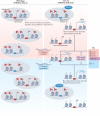Establishment of H3K9-methylated heterochromatin and its functions in tissue differentiation and maintenance
- PMID: 35562425
- PMCID: PMC9099300
- DOI: 10.1038/s41580-022-00483-w
Establishment of H3K9-methylated heterochromatin and its functions in tissue differentiation and maintenance
Abstract
Heterochromatin is characterized by dimethylated or trimethylated histone H3 Lys9 (H3K9me2 or H3K9me3, respectively) and is found at transposable elements, satellite repeats and genes, where it ensures their transcriptional silencing. The histone methyltransferases (HMTs) that methylate H3K9 - in mammals Suppressor of variegation 3-9 homologue 1 (SUV39H1), SUV39H2, SET domain bifurcated 1 (SETDB1), SETDB2, G9A and G9A-like protein (GLP) - and the 'readers' of H3K9me2 or H3K9me3 are highly conserved and show considerable redundancy. Despite their redundancy, genetic ablation or mistargeting of an individual H3K9 methyltransferase can correlate with impaired cell differentiation, loss of tissue identity, premature aging and/or cancer. In this Review, we discuss recent advances in understanding the roles of the known H3K9-specific HMTs in ensuring transcriptional homeostasis during tissue differentiation in mammals. We examine the effects of H3K9-methylation-dependent gene repression in haematopoiesis, muscle differentiation and neurogenesis in mammals, and compare them with mechanistic insights obtained from the study of model organisms, notably Caenorhabditis elegans and Drosophila melanogaster. In all these organisms, H3K9-specific HMTs have both unique and redundant roles that ensure the maintenance of tissue integrity by restricting the binding of transcription factors to lineage-specific promoters and enhancer elements.
© 2022. Springer Nature Limited.
Conflict of interest statement
The authors declare no competing interests.
Figures




Similar articles
-
Argonaute NRDE-3 and MBT domain protein LIN-61 redundantly recruit an H3K9me3 HMT to prevent embryonic lethality and transposon expression.Genes Dev. 2021 Jan 1;35(1-2):82-101. doi: 10.1101/gad.344234.120. Epub 2020 Dec 10. Genes Dev. 2021. PMID: 33303642 Free PMC article.
-
Synergistic lethality between BRCA1 and H3K9me2 loss reflects satellite derepression.Genes Dev. 2019 Apr 1;33(7-8):436-451. doi: 10.1101/gad.322495.118. Epub 2019 Feb 25. Genes Dev. 2019. PMID: 30804228 Free PMC article.
-
Inheritance of H3K9 methylation regulates genome architecture in Drosophila early embryos.EMBO J. 2024 Jul;43(13):2685-2714. doi: 10.1038/s44318-024-00127-z. Epub 2024 Jun 3. EMBO J. 2024. PMID: 38831123 Free PMC article.
-
Structure and function of histone H3 lysine 9 methyltransferases and demethylases.Chembiochem. 2011 Jan 24;12(2):254-63. doi: 10.1002/cbic.201000545. Epub 2011 Jan 5. Chembiochem. 2011. PMID: 21243713 Review.
-
The functions of SET domain bifurcated histone lysine methyltransferase 1 (SETDB1) in biological process and disease.Epigenetics Chromatin. 2023 Dec 7;16(1):47. doi: 10.1186/s13072-023-00519-1. Epigenetics Chromatin. 2023. PMID: 38057834 Free PMC article. Review.
Cited by
-
Prolonged Inhibition of the MEK1/2-ERK Signaling Axis Primes Interleukin-1 Beta Expression through Histone 3 Lysine 9 Demethylation in Murine Macrophages.Int J Mol Sci. 2023 Sep 22;24(19):14428. doi: 10.3390/ijms241914428. Int J Mol Sci. 2023. PMID: 37833877 Free PMC article.
-
Epigenetic mechanisms regulate sex differences in cardiac reparative functions of bone marrow progenitor cells.NPJ Regen Med. 2024 Apr 29;9(1):17. doi: 10.1038/s41536-024-00362-2. NPJ Regen Med. 2024. PMID: 38684697 Free PMC article.
-
Inhibition of SUV39H1 reduces tumor angiogenesis via Notch1 in oral squamous cell carcinoma.PeerJ. 2024 Apr 19;12:e17222. doi: 10.7717/peerj.17222. eCollection 2024. PeerJ. 2024. PMID: 38650654 Free PMC article.
-
KDM4 Regulates the Glycolysis of Hemocytes in the Immune Priming of Eriocheir sinensis.Int J Mol Sci. 2024 Dec 7;25(23):13174. doi: 10.3390/ijms252313174. Int J Mol Sci. 2024. PMID: 39684884 Free PMC article.
-
H3K9 post-translational modifications regulate epiblast/primitive endoderm specification in rabbit blastocysts.Epigenetics Chromatin. 2025 Jan 13;18(1):2. doi: 10.1186/s13072-025-00568-8. Epigenetics Chromatin. 2025. PMID: 39800758 Free PMC article.
References
Publication types
MeSH terms
Substances
LinkOut - more resources
Full Text Sources
Other Literature Sources

